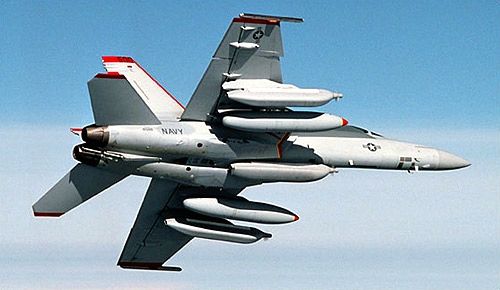LONDON: Farnborough is an air show, but many of the briefings scheduled by American companies this year focus on electronic warfare and missiles — not airplanes. Raytheon, winner of the Next Generation Jammer competition, and the other four defense giants know that much of the money to be made in the next decade will come from upgrades and add-ons, not new platforms. And much of the new money is destined for just the sort of technology the NGJ is sure to bring: the area where cyber and classic electronic warfare now merge thanks to digital technologies such as the AESA radar (active electronically scanned array).
There is news on that front. Since Raytheon’s win over BAE Systems, ITT/Boeing and Northrop Grumman was reaffirmed earlier this year — in spite of BAE Systems’ successful protest — the program has made very little news.
But we can report that the head of the program at Raytheon, Rick Yuse, says the program’s System Readiness Review (intended to ensure the program can meet all its requirements) “went extremely well” late last month.
“It’s a solid design,” he said, “well thought through.” He added that “program execution is near perfect.” Initial flight testing on the jammer’s components is now set for September. Initial Operational Capability (IOC) should happen in late 2020, he said.
Anyone who has followed high technology programs in the military knows that they often suffer much of their greatest angst in the first few years, as requirements get changed, unexpected technology problems arise, and funding wobbles.
Yuse attributed much of the program’s success so far to the fact that Raytheon “had a plan to do a lot of risk reduction very early in the contract.” He told me that virtually all of the technology sits at or above Technology Readiness Level (TRL) 6, which is generally just below production-ready and appropriate for subsystem development. More specifically he said, the program’s four key technologies were at TRL six when they started.
Very little has been said publicly by Raytheon or the Navy about the NGJ, its technologies or its capabilities. Yuse continued that trend, very politely. He described the system as covering both offensive and defensive electronic warfare. It is “initially focused heavily on the air-to-ground mission for air defense.”
Perhaps the most intriguing tidbit from our conversation, which occurred July 2, was Yuse’s mention of “an AESA array that can do EW, coms, radar, SIGINT all at the same time.” Most observers know that AESA can handle EW and radar. But there’s been very little public discussion of AESA’s ability to perform Signals Intelligence (SIGINT) or its ability to serve as a communications array. Aviation Week‘s Amy Butler and I asked Lockheed’s head of the F-35 program on Thursday about whether AESA could serve as a communication’s device, and we got the “I’m not sure I can discuss that” answer.
AESA as a communications device makes sense given its digital nature. If you can turn voice into zeroes and ones, then you should be able to send and receive that information.
Initially, the jammer will be installed on the Navy’s dedicated electronic warfare platform, the EA-18 Growler. Yuse said the pods could also be installed on aircraft such as the Navy’s unmanned UCLASS with relatively few changes required: “It is a very flexible design that does not require a lot of aircraft modifications — we kind of refer to it as smart pod.”
The pod includes algorithms with a data library to read the existing threats or targets and to offer responses. Part of the reason few changes are required for new aircraft is that the pod contains virtually everything needed. “From an operational standpoint it’s pretty independent. It’s not very intrusive into the aircraft’s avionics.”
China’s new H-20 stealth bomber ‘not really’ a concern for Pentagon, says intel official
“The thing with the H-20 is when you actually look at the system design, it’s probably nowhere near as good as US LO [low observable] platforms, particularly more advanced ones that we have coming down,” said a DoD intelligence official.



























